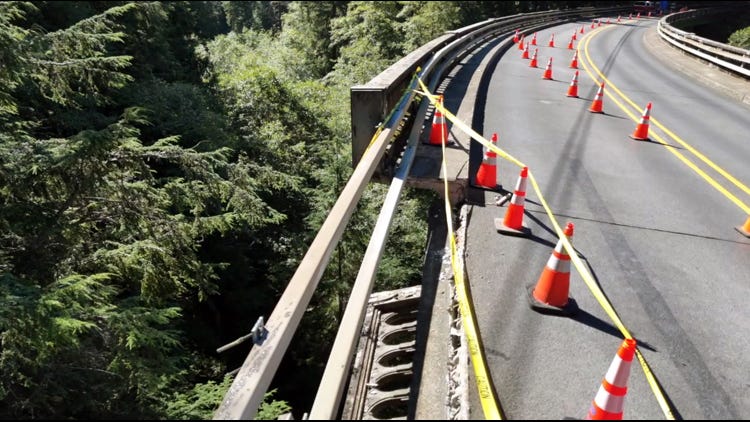EDITOR’S NOTE: Here’s an installment from Tillamook County’s State Representative Cyrus Javadi’s Substack blog, “A Point of Personal Privilege” Oregon legislator and local dentist. Representing District 32, a focus on practical policies and community well-being. This space offers insights on state issues, reflections on leadership, and stories from the Oregon coast, fostering thoughtful dialogue. Posted on Substack, 8/26/25
By State Representative Cyrus Javadi
Politics is full of easy answers. Roads demand the hard ones.
Nobody loves taxes. You won’t find a soul in Oregon who wakes up thinking, “What would really brighten my day? Paying a few extra cents per gallon.”
Fair enough.
But here’s the thing: the roads don’t fix themselves, and neither do bridges when they fall into rivers. And our transportation system is staring at a funding hole big enough to swallow Highway 6 whole.
In the last couple of weeks, KATU ran a poll that said 82% of Oregonians don’t want higher taxes. To which I say: of course. That’s like polling Oregonians on whether they’d prefer free marionberry pie over a root canal.
And yet, here we are. One week away from a special session to decide whether raising the gas tax six cents, bumping the payroll tax, or tinkering with EV fees is the right way to keep ODOT’s maintenance and operations afloat.
This isn’t a crisis that crept up overnight. The system is decades old, stretched thin, and running on fumes. And now, we’re down to two options: the politically convenient one, and the only one that actually works.
Option 1: Cut Our Way Out
Some of my colleagues, and more than a few folks who email me, want to believe we can solve this problem by cutting. Stop funding capital projects. Zero out passenger rail, climate initiatives, DEI programs. Raid every “nonessential” account.
It’s a tempting story. Who wouldn’t rather believe there’s a bucket of wasteful spending that, if drained, could magically cover the shortfall?
The trouble is, math is a stubborn thing.
If you cut every capital project and every non-maintenance program, you’d scrape together about $250 million. Sounds big, until you notice three problems:
- You’re still short. ODOT’s maintenance gap is closer to $300 million every biennium. The cuts buy you two, maybe three years before inflation wipes them out.
- You lose federal dollars. Kill projects, and you forfeit billions in federal matching funds…up to $9 for every $1 Oregon puts in. That means Highway 6, Sand Lake Road, and Pacific City never get fixed.
- You stop building anything. That new work on Highway 26? Gone. Bridge retrofits? Forget it. Counties and cities already struggling after winter storms? They’d be cut off too.
So yes, you can cut your way into a short-term patch. But it’s like heating your house by burning the floorboards: you’ll be warm for a season, and homeless the next.
And let’s be honest: some people pushing this option don’t really want to fix maintenance. They want to kill projects they don’t like, or to score political points by attacking passenger rail or DEI.
That’s not a road policy. That’s a campaign flyer.
Option 2: Raise Revenue
That leaves the hard truth: we need new revenue. Gas taxes, DMV fees, EV fees, payroll taxes. And yes, fixing the weight-mile tax so truckers stop overpaying more than their fair share.
Why? Because Oregon’s State Highway Fund is flatlining. Fuels tax revenue is shrinking 1.5% a year, vehicles are 21% more efficient than 15 years ago, and within a decade most new cars sold here will be electric. Meanwhile, inflation has pushed construction costs up 80% since 2017.
That’s why the potholes feel deeper, the guardrails rust longer, and the snowplows arrive later. We aren’t keeping up.
You can call it taxes, fees, surcharges, or “adjustments.” But at the end of the day, the only way to fill a hole is to shovel something into it. Pretending otherwise isn’t fiscal responsibility, it’s fiscal cosplay.
The People in the Vests
And before anyone says it, no, the problem isn’t the guys in orange vests. These aren’t lazy, overpaid bureaucrats leaning on shovels. They’re the people up at midnight clearing downed trees, cutting back brush, repainting faded lane stripes, and plowing roads in a snowstorm. They’re first responders on the highway shoulder, not line items in a spreadsheet.
When a truck jackknifes on I-84 in the Gorge at 2 a.m., it’s those ODOT workers who show up in the freezing wind. When Highway 101 floods outside of Seaside, it’s the county road crew throwing sandbags and rerouting drivers. When your teenager takes the family car out in the rain and hydroplanes into a ditch, it’s the men and women in reflective gear who reroute traffic, clear the wreck, and make sure no one else gets hurt.
These are the folks whose job description looks less like a bureaucrat and more like a character out of Deadliest Catch. Except instead of hauling crab pots, they’re clearing boulders off Highway 30 in the rain.
The choice in front of us isn’t about them. It’s about whether we give them the tools and fuel to do the job, or whether we wait for Highway 6 to finish turning into a motocross track.
Maintenance vs. Capital Projects: The Buckets Nobody Wants to Talk About
Here’s the thing most people miss: “fixing the roads” isn’t one bucket of money. It’s two. And pretending otherwise is like pretending your grocery budget and your mortgage payment come out of the same envelope. They don’t.
Let me explain:
Maintenance is what the folks in orange vests do every day. Plowing snow off Highway 26 at 3 a.m., patching the same pothole that ate your tire last winter, painting stripes, clearing brush, cleaning up after a semi jackknifes in the Gorge. It’s repetitive, unglamorous, and absolutely essential. If they stop, you notice within hours.
Capital projects are the big-ticket items politicians like to hold press conferences about. Rebuilding a bridge that’s one inspection away from being weight-restricted. Restoring Highway 101 where the hillside keeps sliding into the Pacific. Expanding lanes on Highway 26. And, someday, turning Highway 6 back into a highway instead of a motocross course. These take years of planning, engineering studies, federal permits, and hundreds of millions of dollars.
Now here’s the kicker: we actually have some money for capital projects. Not enough to do everything quickly, but enough to keep inching along. What we don’t have is enough to cover day-to-day maintenance for ODOT crews, counties, and cities. That hole is immediate, constant, and widening.
So when people say, “Just raid the project money and use it for maintenance,” what they’re really saying is: stop fixing bridges, forfeit billions in federal dollars, and still run out of money in two or three years. That’s not fiscal prudence. That’s fiscal cosplay.
Why Not Let the Roads Fall Apart
Some people think, “Fine. Let the roads fall apart. Maybe then government will learn to spend better.”
Here’s the problem: roads are not Netflix subscriptions. You can’t cancel them for a few months to save money and then restart when you feel like it.
Deferred maintenance is not neutral. It’s compounding debt. Every dollar we don’t spend on maintenance now costs $8 to $19 later in reconstruction.
Bridges don’t politely wait until the next budget cycle; they rust, corrode, and collapse.
And the costs aren’t just in concrete and steel. Bad roads wreck cars, jack up insurance rates, slow freight, and kill jobs. Oregon is a trade-dependent state; one in five jobs here is tied to transportation. When trucks can’t get to market because bridges are weight-limited, or tourists stop visiting because coastal highways are closed, we all pay the price.
This isn’t just about smoother commutes. It’s about Oregon’s economic future.
Can Republicans Support Tax Increases?
Um, yes. Heard of Ronald Regan?
I’ve already heard the question more times than I can count: “How can a Republican be in support of raising taxes?”
Here’s the answer. Being conservative isn’t about pretending math doesn’t exist. It’s about responsibility. It’s about stewardship. It’s about making sure we hand the next generation something better than what we found, whether that’s a balanced budget, a strong Constitution, or a safe road to drive on.
Ronald Reagan raised the federal gas tax in 1982. Why? Because he believed in a use tax. You drive, you pay.
That’s not socialism. That’s fairness. That’s accountability.
The truth is, Oregon’s transportation system is a use tax model. The people who drive the roads pay to maintain them. It’s not going into some vague government slush fund. It’s going back into plowing, striping, and paving. If you want the road, you have to pay for the road.
The Choice That Matters
So here it is:
- Option 1: Stop building, sacrifice federal dollars, still fall short, and kick the crisis two years down the road.
- Option 2: Face the music, raise revenue, fix the imbalance, and actually fund maintenance so ODOT and local governments can keep roads safe.
It’s not fun. It’s not popular. But it’s the only adult option on the table.
Closing Note
We can keep chasing the fantasy of a free lunch, or we can accept what every mechanic, contractor, and parent with teenagers already knows: nothing runs without upkeep. Even the Millennium Falcon needed constant repairs.
In politics, false choices are cheap. Real solutions are expensive. Oregon’s roads are asking us to decide whether we want slogans—or asphalt.
If we choose slogans, we’ll keep seeing the same cycle: underfunded maintenance, crumbling infrastructure, emergency patches, ballooning costs. If we choose asphalt—if we choose the hard, honest path of raising revenue—we can actually hand our kids a system that works.
That’s the test. That’s the choice. And it’s time to pick.


